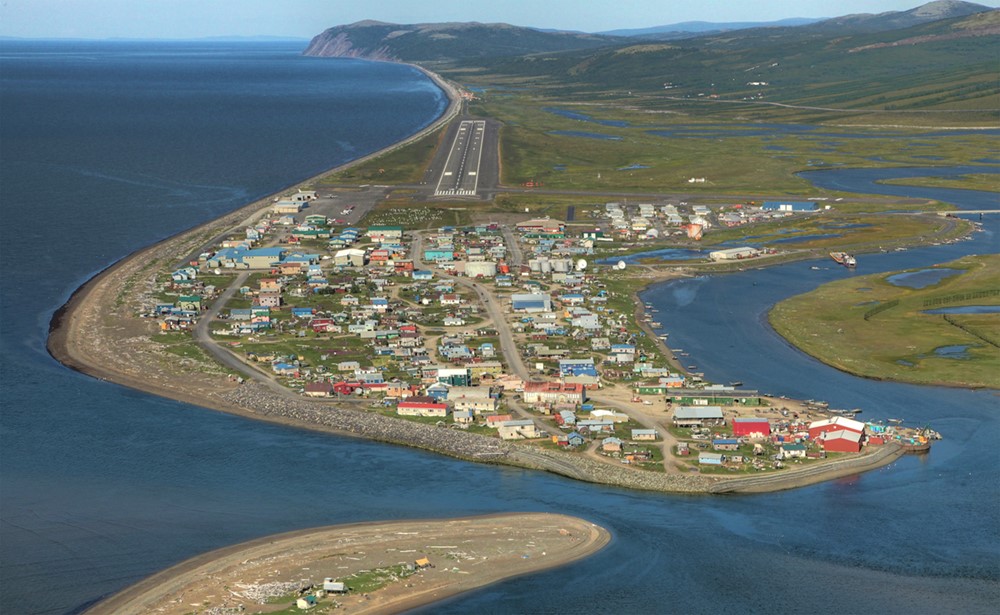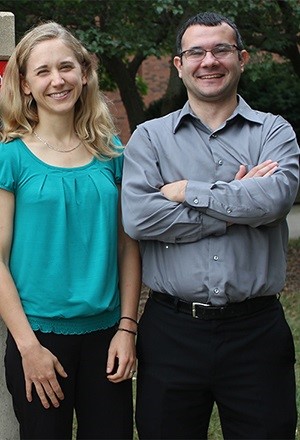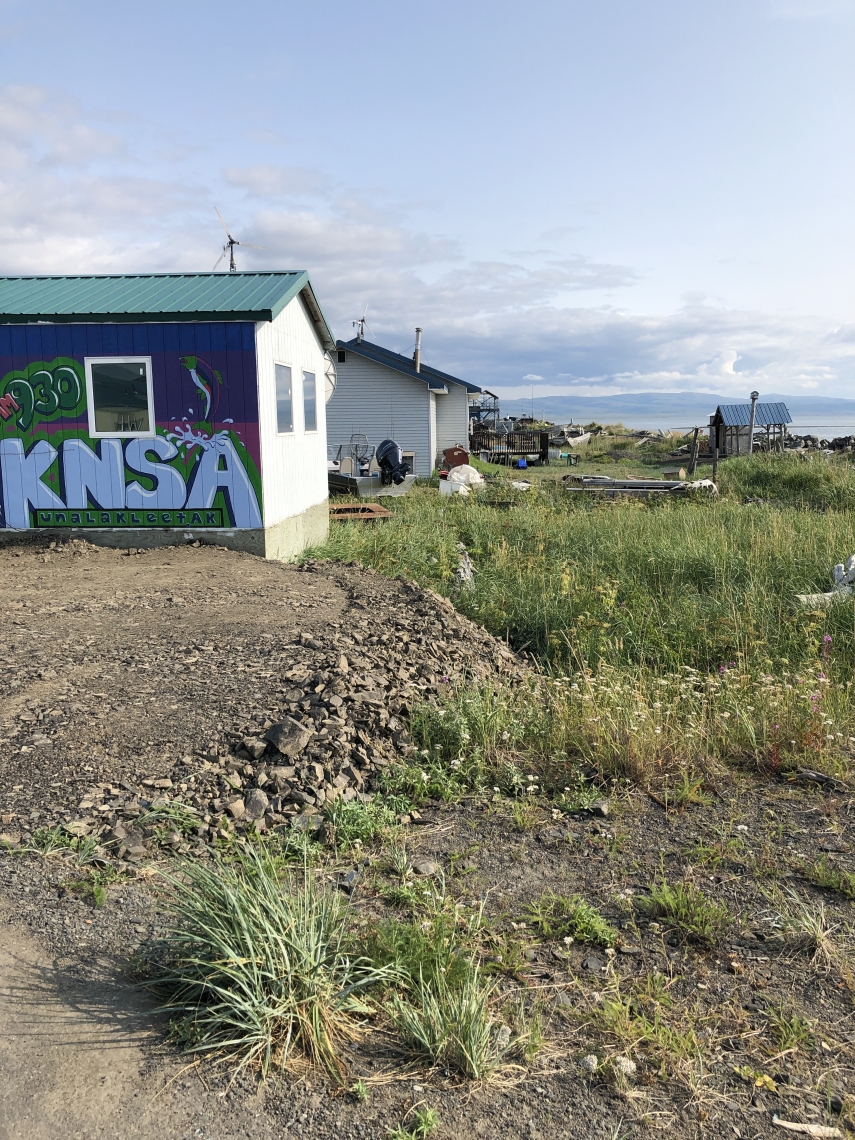No Place Like Home: Addressing the Need for Safe and Healthy Housing in Alaska
- Kristen Cetin, Ph.D.
- Assistant Professor
- Department of Civil and Environmental Engineering
- College of Engineering

City of Unalakleet, Alaska.
A home should be a safe place of refuge from all types of assaults, of which 2020 has had many, including the ongoing impacts of the coronavirus. For Alaska Native communities, these difficulties come on top of the housing challenges they already faced due to increasing environmental and social pressures—challenges that threaten the safety and well-being of their places of refuge.
Kristen Cetin, assistant professor in MSU's Department of Civil and Environmental Engineering, is part of a team of researchers working on a project that addresses housing vulnerabilities due to climate change in rural Arctic regions. According to Cetin, overcrowding, poor indoor air quality, high costs of electricity and fuel, permafrost thaw causing structural issues to building foundations, coastline erosion requiring communities to move their buildings away from the coast, and housing stock being built without consideration of local community values are issues contributing to a housing crisis.
The goal of the project is to identify culturally appropriate solutions to these housing issues, relying both on the multidisciplinary expertise of the research team, as well as local expertise of community members and stakeholders, to ensure that the research is planned and conducted in ways that will benefit the community for generations to come. The research team is working primarily with the community in Unalakleet, Alaska, a village with a population of around 800, south of Nome on the west coast of Alaska, bordered on one side by the ocean and on the other side by the Unalakleet River.
"They are a small community, and we're working with them on housing related issues and on building some new housing," said Cetin. "They haven't had new housing in this community for a while, so they're excited about it and they want to set up the process—make the process 'right.' They want to go through the process of including the community in the development of the housing, so that it's something that people will accept and that will perform well and can be a model for other communities to use in developing additional housing."
Kristen Cetin and her husband Bora Cetin, who is also a faculty member in the Department of Civil and Environmental Engineering, came to MSU from Iowa State University in 2019. They are both working on the Alaska housing research project. While Kristen is addressing concerns around indoor environmental quality, Bora, with his expertise in geotechnical engineering, is addressing structural issues resulting from permafrost thaw. Together and individually, they are part of many collaborative research projects, drawing on their unique skill sets and expertise.
A Transdisciplinary Approach

Kristen and Bora Cetin, Department of Civil and Environmental Engineering, are part of the research team addressing housing needs in Unalakleet.
The project falls under the Navigating the New Arctic (NNA) initiative, one of the National Science Foundation's 10 Big Ideas. According to their website, NNA supports "the research and dissemination of new knowledge needed to inform the economy, security, and resilience of the Nation, the larger Arctic region, and the globe with respect to Arctic change."
The project is led by Cristina Poleacovschi, an assistant professor in the Department of Civil, Construction, and Environmental Engineering at Iowa State University (ISU). She leads an interdisciplinary research team from Iowa State University, Auburn University, and Michigan State University who bring combined expertise in geotechnical engineering, energy and thermal performance, atmospheric science, erosion, and social systems. They are collaborating with local experts from the Cold Climate Housing Research Center, the Tribal Council of Unalakleet, and the housing director in Unalakleet, as well as with members of the Unalakleet community.
With a background in knowledge-sharing in project-based organization, Poleacovschi is addressing the social systems component, working with the housing director to conduct interviews with community members, ensuring that community and stakeholder voices are guiding the research and development of new housing.
"It is exciting to work on a project that has engaged the community from early on," said Poleacovschi. "We have included the community itself and the housing authority in our discussions and meetings to ensure a strong community engagement, which I believe will create stronger research impacts. History shows that, way too often, engineering designs may not follow cultural and historical preferences which can result in unsustainable outcomes. We try to avoid this—making this project unique."
Kari Duame is a key partner on the project. Originally from Nome, after college she reconnected with the Native Alaska community through employment with the Aleutian Housing Authority and is currently the housing director for the City of Unalakleet. She has been vital in making local connections and setting up interviews so that community members can share their knowledge and experience.
"I interact with people in the community a lot," said Duame. "It's the nature of my job, and people share what their concerns are. Besides the obvious—lack of housing—other concerns are the aging infrastructure in the City, elders living in unsafe and unsanitary conditions, and the usual village housing issues like mold and ventilation problems, even in newer housing."
The changing climate is both creating and compounding the housing problems, especially in a village surrounded by water. "Climate change is a concern, and a lot of work has been done to prevent erosion and flooding," said Duame. "However, the City is encouraging new development to occur on the "Hillside," on the hills that rise up just east of town, where new housing will be safe from future flooding."
Bridging Engineering and Culture
With expertise in energy performance, indoor environmental conditions, and ventilation, Cetin is addressing the causes of poor indoor air quality in the homes. Several factors, such as overcrowding and lack of ventilation, can lead to unhealthy conditions, such as mold growth, that make the indoor environment unhealthy. She has collected information from Alaska housing surveys to identify typical building characteristics and issues and has worked with the Cold Climate Housing Research Center to discuss these issues. She and the team are using building simulation tools to mimic the conditions in the buildings to assess and consider possible solutions.
"Many people live in very small and old homes that have a lot of issues with them," said Cetin. "And overcrowding is a big challenge. Housing is designed for a certain number of people, and when you have more people living in tighter quarters, with lots of cooking, it creates a lot of moisture. Moisture is a big problem in these homes—lots of mold, condensation, air quality, and ventilation issues. Groups in Alaska have been working to help improve it, but it's still a big issue."
Cetin is working with Poleacovschi to develop interview questions around indoor environmental conditions. "The purpose of the interviews with local community members is to understand how they perceive these issues of air quality and ventilation," explained Cetin, "so that when we work with the housing director to go through this process of developing new housing, we can make sure that we understand both what should be done and what people understand is the right thing to do and try to bridge that difference—to try to make something that people like and feel is culturally appropriate, but also encourages a healthier environment, and more sustainable building operation."
Impacts of the Coronavirus
Originally, the team's plan was to travel to Alaska in summer 2020 to begin doing hands-on research and face-to-face interviews, but due to coronavirus, the trip has been postponed until 2021.

Unalakleet is a village on the West Coast of Alaska with a population around 800.
"Unfortunately, COVID came right before we planned to go to Alaska this summer, so we couldn't go," said Cetin. "So the data collection has involved talking with people remotely. We developed a survey and sent it out to a diversity of stakeholders to get a sense of what the most important things are to the community, and the way they construct, operate, and maintain housing in the Alaska region. We've also met with the Tribal Council and talked with the housing director, but everything has been over Zoom for the most part. On my end, I've worked with Cristina to develop some questions as part of the interview process related to housing."
The virus has impacted all of Cetin's research—one project even had to be canceled. "We had to stop doing lab work for almost five months, significantly impacting the construction of my lab and several of our laboratory-based research projects," she said. "Project timelines have had to be extended because we are not able to be in the lab to complete work. Mentally it is challenging, and everyone is stressed." And while she is thankful for the ability to develop more flexible means of communication, she says, "It's harder to do work virtually; it's just not the same."
The Unalakleet community has also been drastically impacted by the virus, due to stringent quarantine requirements and unemployment. "There used to be daily flights out of Anchorage, but the air carrier went bankrupt due to COVID, which had a very negative impact on the community," said Duame. "It put a lot of people out of work and also made it hugely expensive to leave the village. We had some CARES act funding that we used to pay three months of rent and utilities for those who were out of work, but it wasn't enough when the crisis continued."
Planning Post-Virus
Looking ahead, the team plans to use the collection of data and information from this planning grant to help with the submission of a larger collaborative grant. This would allow the team to begin applying their research into the design and construction of new housing.
Cetin is hoping the new year will bring an opportunity to continue the research in person, as she enjoys doing work that allows her to collaborate with and learn from an interdisciplinary team of researchers and community members.
"As a result of the collaboration you learn so much from each other and from the project efforts and expand your knowledge base, not only in your own field but in other fields as well," she said. "I enjoy being able to work with a community and in a location where there are significant challenges and opportunities for collaboration where research related efforts can help improve living conditions."
Hopefully, in 2021, that collaboration will be on the ground in Unalakleet.
- Written by Amy Byle, University Outreach and Engagement
- Photographs courtesy of Iowa State University, Kari Duame, and Andreanna Grishkowsky